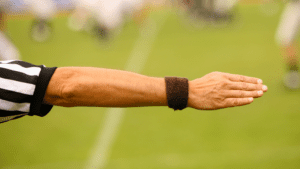It hardly matters whether you’ve played tennis for years or are picking up a racquet for the very first time, learning and executing the various grips can be a crucial part of any aspiring athlete’s game. And, believe it or not, it is far more complicated than just holding it like you might use a baseball bat or a hockey stick.
On a very basic level, the different grips affect the way you hit the ball, its pace, spin, distance, and, ultimately, where you make contact with the ball on the court. For different strokes, tennis players must adjust their grip on-the-fly to the correct position so they can hit the perfect shot. Between serving, volleying, hitting ground strokes, and slicing, tennis coaches always focus on using the correct grip for each specific shot. Check out CoachUp’s handy guide to grips in order the make the most of your next match!

Like Clockwork
When looking at the handle of a tennis racquet, the base is an octagon made up of eight edges that are referred to as bevels. If you hold the racquet up as if you were about to hit a forehand, the bevels count clockwise from one to eight. Thus, for example, the third bevel, which will now be referred to as B3 from here on out, would be the edge to the immediate right of the octagon. B5 would be straight down from B1, and B7 is the edge to the far left, just to get perspective on the four cardinal directions. The guide will use these throughout the rest of the piece, as they’re unbelievably key to creating your desired result.
CONTINENTAL GRIP
Put the base knuckle of your index finger on B2 to make a V-shape with your thumb and forefinger on top of the handle. For lefties, put your knuckle on B4. This serve is primarily used for serves, volleys, overheads, slices, and defensive shots — so, a jack-of-all-trades, to say the least. The Continental Grip gives the athlete an explosive, versatile shot that puts less stress on your arm. When volleying, it provides an open racquet face for underspin and control. It is, in fact, the most commonly used grip in tennis.
EASTERN FOREHAND GRIP
Here, you’ll want to put your hand flat against the strings and slide your hand down to the grip. Pretend you are shaking hands with the racquet grip. Your base knuckle should be on the right side of the racquet, on B3. This grip is particularly helpful while learning how to hit a forehand. It’ll allow the athlete to hit mostly flat with some minor topspin. Generally speaking, the Eastern Forehand Grip is great for quickly switching to another grip when necessary, so it’s a good starting point for beginners.
SEMI-WESTERN FOREHAND GRIP
Move your knuckle one bevel clockwise from the Eastern Forehand Grip to B4. This allows players to put more topspin on the ball, which is perfect for lobs and quick, tiny angles. Thus, players are often able to hit the ball much harder because the topspin will help it stay in play. Use this grip if you’re looking for a shot with power, control, topspin, and greater margin error for getting it over the net.
WESTERN FOREHAND GRIP
For a full Western Forehand Grip, slide that knuckle one more bevel clockwise from the Semi-Western Grip to B5. This will be the grip you want to use to put as much topspin on the ball as possible. In fact, this is the best grip for maximum topspin, so use it to your advantage! Even if you catch the ball at a super high angle, the extra load of topspin should help it drop past the net. This shot pushes your opponent back in the court behind the baseline, which might set you up for an easy winner.
EASTERN BACKHAND GRIP
First, go all the way to your Continental Grip at B2, from there, shift your knuckle one bevel counterclockwise, and clockwise for lefties, so it’s now on top of the grip completely at B1. You’ll often see these serves in backhand and kick serve situations. It’ll provide stability in the wrist and allows a player to hit the ball with spin. As an added bonus, the Eastern Backhand Grip is easy for transitioning into a volley.
SEMI-WESTERN BACKHAND GRIP
Keep that rotating train going! This time, move the base knuckle of your index finger one bevel counterclockwise from the Eastern Backhand to B8. This will, naturally, be similar to the Semi-Western Forehand Grip and will help you close the racquet face so that you can strike the ball higher and further in front of you with topspin. However, this is a generally advanced grip to use, so beginners may want to focus elsewhere in the early stages.
TWO-HANDED BACKHAND GRIP
This one, of course, will feature both of your hands in order to stabilize and launch a powerful return. You’ll want to use your dominant hand in a Continental Grip and your non-dominant hand above it in a Semi-Western Forehand Grip. So, for right-handed players, put your right hand at B2, and your left on B7 or B8, depending on what feels more comfortable. It’s a great, controlled way to return serves and low shots and helps provide extra power for balls at shoulder level.
(Related: Read about the most popular types of tennis serves here.)
Huddle Up
At the end of the day, tennis grips can definitely be a little intimidating to approach, but keep at it! Once you learn a few more of the simpler techniques, you’ll gain enough confidence to tackle the more advanced ones as well. But, if you’re still having trouble with your swings and grips, consider booking one of CoachUp’s private trainers to help you out. Our instructors have decades of experience under their belt and want to get you on the right track for success. What are you waiting for?
Be prepared for the biggest moments by mastering the small ones off the court.
How useful was this post?
Click on a star to rate it!
Average rating 3 / 5. Vote count: 2
No votes so far! Be the first to rate this post.



